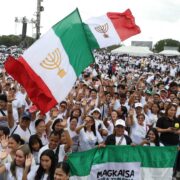Napocor, K-Water team up for flood management in dams
The National Power Corp. (Napocor) has partnered with Korea Water Resources Corp. (K-Water) to study a collaboration in dam safety to boost flood management in the country.
According to Napocor, K-Water, a water management corporation based in South Korea, expressed interest in expanding its technical cooperation with Napocor and utilize “state-of-the-art technology” for dam safety.
K-Water chief executive Yun Seog-dae likewise committed to pursue possible joint projects with the state-run corporation for Angat Dam in Bulacan province, Napocor said.
“[Napocor] also took the opportunity to discuss the importance of the official development assistance project for the Angat Dam flood management and the previously requested collaboration and support from K-Water for its implementation,” Napocor said last week.
Angat Dam supplies the water and irrigation needs of Metro Manila and nearby provinces.
Napocor previously said that the dam’s structure needed to be strengthened to prevent flooding in nearby and downstream areas.
In 2019, Angat Hydropower Corp. (AHC) completed construction work meant to strengthen Angat’s structure “to ensure its stability and safety to withstand the potential risk posed by possible seismic activity associated with the West Valley Fault.”
K-Water was also a proponent in AHC’s project.
Napocor also recently agreed with the National Irrigation Administration (NIA) to jointly implement a water resource management plan in an irrigation system within the Makiling-Banahaw Geothermal Reservation (MGBR) in Laguna province.
Through their memorandum of agreement, Napocor committed to provide its consent and technical assistance for the project, while NIA will provide funding throughout the project implementation, or until 2026. NIA did not disclose its total investment in the project.
Under Executive Order No. 224 series of 1987, MGBR, a 165,690-hectare area spanning Laguna, Batangas and Quezon, falls under the management of Napocor. INQ

















